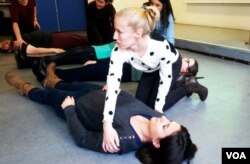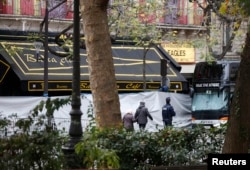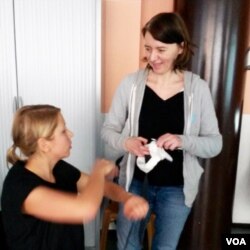Some experts believe last year’s terrorist attacks in Paris may only be a preview for even deadlier strikes to come. In the French capital, area firefighters are conducting workshops on life-saving first aid techniques.
A shootout outside a cafe. Chairs overturned. People lying on the ground, some bleeding heavily. A woman calls for emergency services. She has basic first aid training. She is told what to do until help arrives.
Stop the flow of blood. Move people into positions so they can breathe. Move quickly to treat the most serious cases.
Classes in first aid techniques
Such a scenario facing about a dozen Parisians one recent afternoon was not real. The group was taking a two-hour class in first aid techniques at a fire station in the city’s northern Montmartre neighborhood.
Fire station commander Fabian Testa organizes the weekly workshops in half a dozen fire stations around the French capital. The course will soon be extended to outlying suburbs.
By June, firefighters hope to train about 8,000 area residents in basic life-saving techniques.
Last year’s terrorist attacks in Paris have lent urgency to their mission. The November 13 assault killed and injured nearly 500 people.
Enrolling the public
Testa says when firefighters performed first aid at the attack sites, Parisians asked how they could help. The course was designed to show how simple gestures save lives.
The course teaches techniques like how to apply a tourniquet or reposition a wounded person so his or her airway stays open and that person can breathe. People practice giving CPR or a cardiac massage on mannequins. The lesson: in a crisis, every minute counts. It's a lesson that's also being taught to civilians elsewhere, amid worldwide fears of more terrorist attacks.
Gosia Kotula took the training. She has spent time in Paris as well as Brussels, another city affected by last year’s attacks.
“Now many people start to have a second reflection about what has happened. The reflection of how would I react?…What would I do if something happens? And we just realized that we really know nothing,” she said.
Another Parisian, Loic Kempf, had wanted to take first aid training for some time.
“We learned to evaluate first if someone is unconscious or well. And then we tried heart massage and defibrillator...we learned to stop the bleeding," he said.
That knowledge won't stop a future attack, but will give Kempf tools to save lives should one occur.












